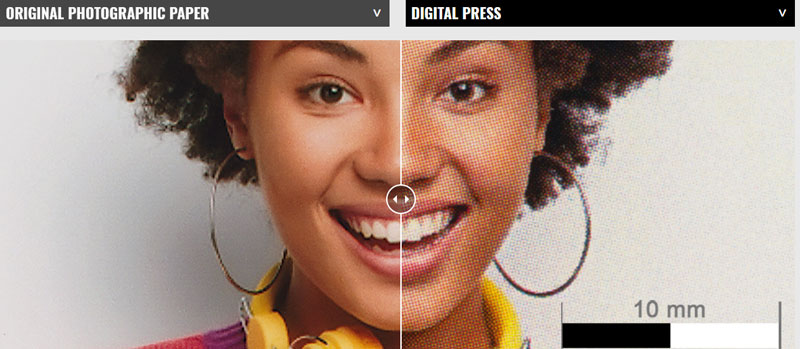In discussions with Inside Imaging last week, David Honey, Richard van den Bergh and Tom De Rop, key executives in Fujifilm Europe’s Photo Imaging Products Division, emphasised that Fujifilm is ‘100 percent committed to silver halide’.

This comes at a time when Fujifilm’s chief competitor in silver-based paper and photochemistry, Sino Promise, is withdrawing Kodak-branded paper and chemistry from the North American and Australian markets (and most likely the entire world), placing big challenges on Fujifilm to maintain supply for existing and new customers.
To summarise, Fujifilm aims to take on the challenge of supplying existing and new customers around the world with Fujifilm Crystal Archive paper products and the photochemistry to process it. Silver halide paper is still used in some retail and professional labs around the world, and more extensively in high-volume prolabs.
Fujifilm’s position is more equivocal when it comes to 35mm film, where it says it will need to work successfully with ‘other companies’. While the Fujifilm executives we spoke to would not confirm it, it’s generally accepted in the industry that at least two Fujifilm colour negative films are manufactured by Eastman Kodak Company in the USA.
Actions supporting these words of commitment to silver halide technology include a pending announcement of new silver halide paper which is more environmentally friendly, by way of being compostible; heavy investment in the paper manufacturing facility in Tilburg; and new developments in silver recovery.
There’s also been a renewed emphasis on sales and marketing (hence this interview) and a dedicated https://www.originalphotopaper.com website for silver halide retail customers and enthusiasts, underscoring the message that Fujifilm is in the silver halide market for the long-term.
This continued commitment to silver halide technology is not part of the narrative outlined in the overarching Fujifilm VISION 2023 document released in 2021, which focuses sharply on healthcare, medical and ‘materials’ as the future direction of the company, downplays the photographic division, and barely mentions silver halide technology at all.
 ‘Those references to Fujifilm investing in medical are all from the corporate website, and those words are black and white, but there is some interpretation,’ said David Honey, general manager, Sales & Marketing, Fujifilm Europe (pictured right).
‘Those references to Fujifilm investing in medical are all from the corporate website, and those words are black and white, but there is some interpretation,’ said David Honey, general manager, Sales & Marketing, Fujifilm Europe (pictured right).
‘Fujifilm’s Vision detailed on our Corporate web pages is very much an investor relations message to explain our steps forward into healthcare and other markets where we see our proprietary technology being a distinct advantage.
‘Our history in photo is very much the “core of our DNA”, however the narrative for the market dynamics in traditional silver halide is not so interesting for those wanting to track the future of Fujifilm’s business transformation.
‘Even though we have our supply challenges, we still try to do our best to supply the paper market for the entire world from the factory in The Netherlands.’
Paper & Photochemistry
Fujifilm has one remaining paper factory in Tilberg, The Netherlands, and two photochemical factories – one in Belgium and the other in Singapore. It has ceased paper manufacture in the USA. If Sino Promise shuts shop entirely, that one paper factory will face the challenge of supplying virtually the entire world with colour silver halide paper.
‘We can’t change what’s going on in the marketplace because its quite dynamic and constantly shifting and in the past few years we have quite often been challenged by the exit of other manufacturers and trying to do our best to maintain supply,’ said David.
‘The current issue is the apparent exit of Sino Promise. We are not quite sure which markets they are exiting from, having seen various reports, but definitely North America.’
He concedes that filling the breach won’t be easy. ‘It’s the big question for us,’ he said. ‘We have other technologies making great digital cameras, sensors, and processors for digital imaging.
‘In silver halide we also manufacture the Instax system and then in other parts of the business we have silver technology for our diagnostics business and medical.
‘So we are quite good at using silver in different ways, but when it comes down to the core photographic system the issue we have now is that we seem to have moved on from the competitive world of selling.
‘So we don’t really worry so much any more about whether our paper is better than Kodak’s, or our film is better than Kodak or Konica or Agfa, because a lot of the competition seems to have gone away.
‘What we are concerned about now is the ecosystem of silver halide. How to keep silver halide as the premium quality photographic system. Particularly for printing. So a lot of the work we are doing in Holland is around sustaining this silver halide ecosystem.’
He said that raw material supply for paper is reasonably good; for chemistry raw materials procurement ‘can be sometimes a bit of a challenge’; and more so for film. Fujifilm withdrew most film products from the domestic Japanese market earlier this year citing difficulty in procuring raw materials, and has been de-ranging its film portfolio over the past few years.
Tom De Rop, business manager, Photo Imaging Products, who manages the photochemicals business from Belguim, confirmed that ‘chemistry for CN16/C41 films and E6 films is very much part of the future.’
He said procuring the raw materials is gradually getting back under control after Covid and other disruptions. ‘Like many other industries, the pandemic, the Ukrainian war and high energy prices had their repercussions on our industry, but as the world has gone gradually back to “normal”, we have our supply of raw materials under control.
‘Our senior management stresses on keeping a full ecosystem of paper and chemistry in hand, in close cooperation with the equipment manufacturers.’
Fujifilm has no plans to outsource photochemistry manufacture or collaborate with competitors such as Champion (CPAC) or Tetenal.
‘We don’t see the need to do so,’ said Tom. ‘Our plant has enough capacity, raw materials and packaging materials to respond to any kind of demand that the market lays upon us – [existing] customers or prospects.
He said that apart from discontinuing its already limited black and white product range a couple of years ago, Fujifilm offers a full complement of photochemicals. To back up the claim he attached the current 21-page product list. He said that the Belgium factory supplied Europe, Middle East and Africa, plus Asia and the Americas, while a sister plant in Singapore handled the Asia-Pacific region, including Australia and New Zealand.
Bio-degradable paper
Richard van den Bergh, business manager, Photo Imaging Products, Fujifilm Europe (photographic paper) expanded on the development of a more bio-degradable silver halide paper:
‘We take out the polyethylene layers and use a bio-plastic. We had the first test samples at end of March and those were looking good…so in June we will do the first production with our (bulk paper stock) supplier Felix Schoeller
‘If you use the product normally – keep it in an album or a photo book, on a shelf or handing on the wall, nothing will happen. But once you decide you no longer want this photo of, say, your ex or whatever, you can compost it.
‘I think in the industry our competitors like HP or Canon often refer to silver halide as being old and dirty, which is not the case in my humble opinion. We are developing a more closed and better process.
He said they were also working with water purification specialist Lenntech on new silver recovery systems using a resin which will recover all the silver in wash water on-site. Silver attaches to the resin until it is saturated.
‘This system will basically pay for itself within a year or so because of the amount of silver you take out. The residue you put into the drain is way, way cleaner than what any government requires.’
He added that this was a ‘big lab solution’, too large an investment for a smaller photo specialist.
Photographic film
As mentioned, while Fujifilm is going it alone with paper and chemistry it will increasingly look to ‘other companies’ to collaborate on film manufacture.
‘We are not too keen to say too much about film, but it’s now at a state where it’s difficult to sustain supply of a lot of different brands. So we do work quite closely with another company to keep film on the market, but it’s never easy,’ said David.
‘Making film is a massive volume enterprise,’ he explained. ‘You have to have huge machines running 24/7 making this stuff, and if there isn’t a big enough worldwide demand for that type of product it becomes a bit tricky to make sure that you can continue to supply, particularly the huge array of different emulsions that photographers want.’
‘It’s difficult to scale up,’ added Richard van den Bergh. ‘In a previous world where everything went down volume wise, we now see again that young people have discovered this fun world of analog and they are also heavily investing. It is quite difficult to turn the decline up again into an increase in supply.
‘You need equipment and you need smart people. It’s not an easy product to produce.’
(He is right. The complexity of the process of laying micron-thin layers of chemically complex emulsion onto a film base sits comfortably in the ‘Elaborately Transformed Manufactures’ class, and can be compared to making image sensors in terms of tight tolerances and the precision required. And most of the process is in total darkness! Perhaps why there is so much ‘Not Quite Right’ film currently on the market.)
‘Film supply problems are pretty much everywhere,’ said David Honey. ‘The demand is in excess of the ability to supply. It’s in every market. What that really means is that probably 50 percent or whatever of demand is supplied, which is great on the one hand, but that means you probably have 50 percent of the market shouting and screaming because they can’t get product.
‘Sometimes it’s a manufacturing constraint. Simply being not fast enough to be able to manufacture film. Sometimes its procurement of raw materials, which can be a bit tricky. And actually, sometimes, it’s also the people.
‘The world of analog is quite old and people in the factories retire. It’s difficult to actually get new technicians who are brilliant at chemical technology for film.
‘You can build new machines, but getting people to run them is tricky.’
Compounding the supply/demand disconnect is the increasing interest in single use cameras.
‘There’s a trend at the moment for young people to be quite interested in using SUCs at festivals or parties or down at the beach. It’s become quite a big trend. But of course the demand for SUCs is sucking even more 35mm neg film out of the market.’
Price rises
From a customer’s point of view, silver-based products have been blighted by hefty and regular price rises over the past few years. Richard van den Bergh put this down to rising costs.
Marketing push
Accompanying this re-invigoration of its silver halide business, Fujifilm Europe has been promoting the sector to customers.

‘In the past, Fujifilm sometimes relied on making great products which sell themselves,’ said David. ‘Customers have been asking since 2015 to give us the tools to explain what silver halide is, so we created a website, logos, and tools like sliders showing the difference between lustre and matter – because how do you explain that online?
‘But also the differences between inkjet and silver halide and digital press. So it’s tools to explain “we chose silver halide, and this is why”.’
The dedicated website, www.originalphotopaper.com is due for a re-design this year and ‘will be an umbrella for all silver halide, not just paper’.
To conclude, Richard remarked: ‘We are still investing heavily in the factory. In people and machines. We just recently installed a new paper slitter.
‘The love for photo imaging within Fujifilm is very, very big. It’s really still a very important part of our DNA as well as our product turnover. We are still very much committed to the compete ecosystem.’





“it will increasingly look to ‘other companies’ to collaborate on film manufacture” Who else makes colour film other than Kodak?
Kodak can’t keep up supply with its own label unless they are making higher profits coating for Fuji why would they bother?
Dunno. Maybe Fujifilm will pay its bills quicker than Kodak Alaris! But Eastman Kodak is in fact manufacturing film for Fujifilm.
C Prints are overrated. Better archivability with archival pigment inkjet and also a wider color gamut. I would be quite happy to see this technology go.